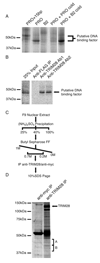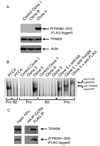Embryonic stem cells use ZFP809 to silence retroviral DNAs
- PMID: 19270682
- PMCID: PMC2676211
- DOI: 10.1038/nature07844
Embryonic stem cells use ZFP809 to silence retroviral DNAs
Abstract
Embryonic stem cells (ESCs) and other primitive stem cells of mice have been known for more than 30 years to potently block retrovirus replication. Infection of ESCs by the murine leukaemia viruses (MLVs) results in the normal establishment of integrated proviral DNA, but this DNA is then transcriptionally silenced, preventing further viral spread. The repression is largely mediated by trans-acting factors that recognize a conserved sequence element termed the primer binding site, an 18-base pair sequence complementary to the 3' end of a cellular transfer RNA. A specific tRNA is annealed to the primer binding site sequence of the viral genomic RNA, and is used to prime DNA synthesis. This same sequence in the context of the integrated proviral DNA is targeted for silencing in ESCs. We have recently shown that a large protein complex binding to the primer binding site in ESCs contains TRIM28 (refs 8, 9), a well-characterized transcriptional co-repressor. An important question remains as to the identity of the factor that directly recognizes integrated retroviral DNAs and recruits TRIM28 to mediate their specific silencing. Here we identify the zinc finger protein ZFP809 as the recognition molecule that bridges the integrated proviral DNA and TRIM28. We show that expression of ZFP809 is sufficient to render even differentiated cells highly resistant to MLV infection. Furthermore, we demonstrate that ZFP809 is able to potently block transcription from DNA constructs of human T-cell lymphotropic virus-1 (HTLV-1), which use the same primer tRNA. These results identify ZFP809 as a DNA-binding factor that specifically recognizes a large subset of mammalian retroviruses and retroelements, targeting them for transcriptional silencing. We propose that ZFP809 evolved as a stem-cell-specific retroviral restriction factor, and therefore constitutes a new component of the intrinsic immune system of stem cells.
Figures




References
Publication types
MeSH terms
Substances
Grants and funding
LinkOut - more resources
Full Text Sources
Other Literature Sources
Molecular Biology Databases
Research Materials
Miscellaneous

